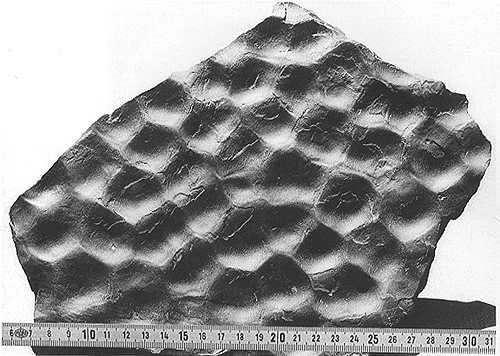
Interference ripples
Plate 52

Interference ripples
Plate 52
The use of the term ripple for this polygonal structure seems puzzling, ripples being essentially linear structures like those we have seen in previous images. This honeycomb pattern was once interpreted in another way, i.e., as a biomechanical structure named tadpole nests. Actually, tadpoles living in shallow ponds move by waving their tails. The slight agitation of the water is sufficient to move fine sand and silt grains below the small organisms and to accumulate it aside. The competition for space between individuals of about the same strength produces pits of about the same size, whose shape is dictated, as in the case of honeybees, by optimal utilization of space.
If one looks carefully at the picture, one can detect, throughout the polygonal pattern, certain alignments of crests suggesting that the structure could also represent the interference or intersection of small ripple systems with different orientation. In any case, this curious structure is valuable as environmental indicator: it formed under an extremely thin water cover, and the environment of origin was emergent or almost so (from littoral-intertidal to continental).
The specimen is a thin slab of siltstone from the Old Red Sandstone, U.K., and belongs to the collection of the Department of Geological Sciences, University of Bologna.